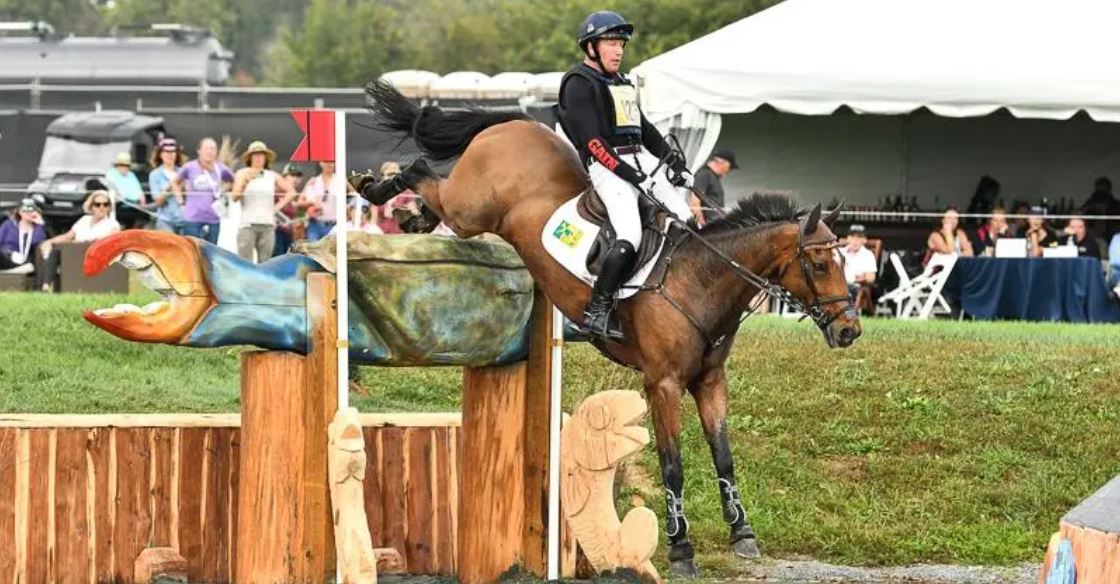|
By: Makena Vass The sun has just crested the hill; the warm light sparkles on the morning dew; the cool air blows red and yellow leaves off nearby trees. Birds sing, greeting the new day. Horses nicker in anticipation of breakfast. But this fall day is not about pumpkin pie or turkey; the peaceful scene only lasts for a few moments as competitors, groomers, and staff have a full day ahead of them. On October 15, Maryland 5 Star hosted its second cross country day at Fair Hill, an equestrian venue in Elkton, MD. Since the Inaugural Event in 2021, horse enthusiasts have flocked to Fair Hill to watch the best international horse and rider teams compete in their sport: eventing. The competition is incredible, and Maryland is extremely lucky to host it as there are only seven Five Star Events in the world, two in the United States (Maryland and Kentucky). Five Star refers to the level of the sport. A Five Star rider is a pro athlete while a One Star rider is just dipping their toes into the upper levels of the sport. The competition itself consists of three phases that occur over three days: dressage, cross country, and show jumping. Maryland is a hotspot for eventing, but people outside of the horse community rarely have any idea what it is. Despite all that goes into being an equestrian of any discipline, whether Five Star or elementary, many are quizzical about its classification as a sport. To some, it may seem that the horse does all the work, but Glenelg junior Matt Rosenhyslop and senior Maya Bombhardt say otherwise. Rosenhyslop rides three to four days a week and has done so for eight years, but that doesn’t make a show any less busy. A show day means waking up at 4 a.m. to get ready to ship out at 5:30 a.m. Once at the show, Rosenhyslop warms up and waits to go into the arena for the multiple classes that will fill the day until 7 p.m. Riding is not something that only takes place on the horse. According to Bombhardt, who has been riding for seven years, it is common for a rider to “spend about five hours at the barn for about two minutes actually in the ring.” If a traditional sport that has a game lasting an hour requires those parameters, it would take 150 hours of practice per game. Equestrian sport is laid out differently than others, but that is not a reflection of the amount of work that goes into the time spent actually competing. Still, the horse world remains unknown to many. Horse sport is as native to Maryland as blue crabs, but Bombhardt fears that, “a lot of people don’t know anything about horse riding, so I guess it would be nice for it to be more recognized as a sport.” Glenelg has a number of equestrians that put in just as much, if not more, work into their sport as some of the mainstream sports, but it still does not get that credit because people constantly discount it for being a ‘lazy’ sport. However, the three days of intense competition in eventing prove otherwise. To start the competition at Fair Hill, riders complete the dressage phase. In this, a horse and rider team must complete a series of movements around an empty arena in the best, most sophisticated way possible. The goal is to match the textbook examples of equestrian sport and whoever does so the best gets the lowest score. Dressage is vital to eventing, but it is cross country that makes the sport stand out. It requires riders to leave the arena and take on the open fields to jump wild obstacles at a full gallop. This is the most dangerous part of the whole three days as there are log jumps up to 4.1 feet tall with deep ditches under them, step-ups and step-downs, water crossings, and massively wide tables. One jump at the Maryland 5 Star is a crab-shaped obstacle with a drop into water on the other side. There are usually around 40 jumping efforts in this leg, making it a measure of both endurance and skill. A miscommunication between horse and rider on cross country day can be fatal, but when done safely, it can create a massive rush of adrenaline. As far as scoring goes, a fall on the course is an elimination and a refusal or going over the preset time is a penalty, which is added to the dressage score. The same scoring applies to the final phase: show jumping. In show jumping, riders race around a technical course of stadium jumps. If a team knocks down a jump’s rail, they also receive a penalty. Like other mainstream sports, eventing has a winner and a loser and all the excitement in between. Even so, the Maryland 5 Star remains to be one of the few opportunities equestrians have to compete against the best of the best and bring more exposure to a sport that has been a staple in Maryland, and, because of the state's many horse-racing events and number of horse farms, the sport has contribute[d] to Maryland's reputation as "horse country." To support Maryland’s large equestrian population and learn more, please visit Maryland’s government website.
0 Comments
Leave a Reply. |
Archives
May 2024
|
